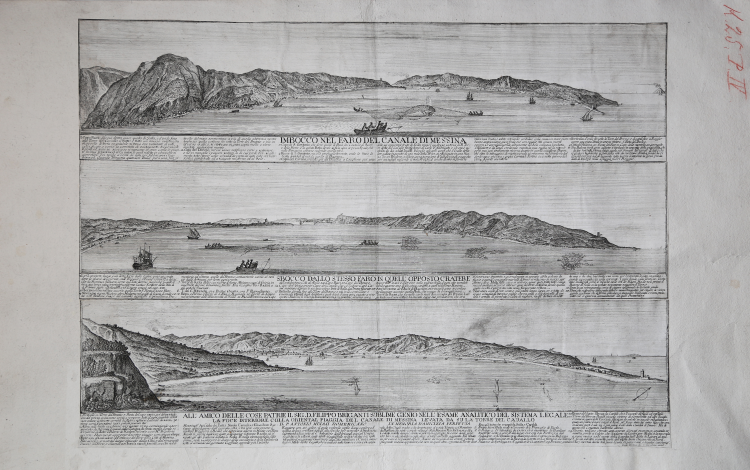- New



| Reference: | S51919 |
| Author | Antonio MINASI |
| Year: | 1776 |
| Zone: | Strait of Messina |
| Measures: | 615 x 445 mm |


| Reference: | S51919 |
| Author | Antonio MINASI |
| Year: | 1776 |
| Zone: | Strait of Messina |
| Measures: | 615 x 445 mm |
Very rare view of the Strait of Messina, drawn and engraved by Willem [Guglielmo] Fortuyn, published in 1776.
It belongs to the extremely rare corpus of views of Calabria and the Strait of Messina—an unknown number of panels, probably 24—the result of the collaboration between the Dutch-born painter Fortuyn and the philosopher and naturalist Antonio Minasi from Scilla.
In 1773, Minasi was commissioned by Pope Clement XIV to undertake a full-fledged mineralogical journey to the Kingdom of Naples to collect not only volcanic rocks and fossils, but also life drawings of views of all the notable places in southern Italy, to create paintings that would adorn the natural history cabinet of the museum then being established in the Vatican.
Antonio Minasi, philosopher, naturalist, and a prominent figure in 18th-century Calabrian view painting, is associated with several scientific works. He was born in Scilla on May 20, 1736. He entered the Order of the Fathers of the Preachers, earning a degree in theology. He deepened his knowledge of oriental languages, particularly Greek, but above all, the natural sciences, which became the main focus of his studies. He spent several years in the convent of San Domenico in Soriano, then in Reggio, where he developed a passion for studying the optical phenomenon of Fatamorgana; during the same period, he made discoveries in the world of botany and zoology.
Willem or Guglielmo Fortuyn (documented 1752–1778), a Dutch painter and engraver, specialized in vedute from his native years, was active mostly in Italy in the last forty years of the eighteenth century. The few records of Fortuyn are scattered between a short Dutch article written in the early twentieth century and the few lines found in a few specialized biographical dictionaries. The best-known and most published phase of Guglielmo Fortuyn's Italian career is undoubtedly that spent with Antonio Minasi. In 1773, Minasi, newly appointed professor of botany at Sapienza University, was commissioned by Pope Clement XIV to undertake a mineralogical journey to the Kingdom of Naples with Fortuyn. The two departed under the best of auspices, but their mission was never completed, annulled by the sudden death of the controversial Pope Ganganelli (1774), who therefore never saw the collection of Vesuvian material and southern landscapes he had commissioned. Meanwhile, the scientist and his painter remained together in the Kingdom of Naples and continued to paint landscapes at least until the early 1780s, perhaps in the hope that Clement XIV's successor, Pius VI, would confirm the assignment entrusted to them.
An illuminating example of the fruit of this collaboration is an anonymous article appearing in issue 20 (Florence, May 15, 1778) of Novelle Letterarie, a Florentine weekly edited by Giovanni Lami. It discusses the “Tavole Topografiche e pittoresche di tutto il littorale del Regno di Napoli, ornate di molti aneddoti fatti di Storia Naturale e disegnate sotto gli occhi dell’autore. Lo scopo di quest’opera originale è di mostrare in 24 tavole in foglio imperiale tutto il periplo del Paese di Napoli…”. [Topographical and picturesque tables of the entire coastline of the Kingdom of Naples]. The article lists the titles of the first six published plates, which were on sale "from Mr. Ermil, and from Mr. Domenico Terres, a Neapolitan bookseller".
It is clear, therefore, that by 1778, Minasi and Fortuyn had completed their survey of the entire Bourbon kingdom, producing views not only of the most significant places from a naturalistic perspective, but also from a historical and antiquarian perspective. The naturalist had in fact produced at least 24 drawings during his stay in southern Italy; these, engraved on a large scale and adequately commented by the scholar, were intended to form a valuable text for wealthy and cultured enthusiasts. The fact is, however, that this text, which the Florentine author claims will be published soon, has no trace whatsoever. This suggests that, in all likelihood, for reasons yet to be ascertained (but certainly not entirely unrelated to the considerable financial burden involved), it was never published. The main reason for the failure of the publishing project may have been the failure to secure the necessary number of financial backers (associates) to continue the work; but this circumstance alone is not sufficient to explain the disappearance of most of the drawings related to the work.
As mentioned, due to the death of the commissioning pope, all the other views of southern Italy collected by the two travelers most likely never saw the light of day, or at least are now considered lost. Only eight of them were published under the title Tavole Naturali Istoriche di Scilla e Cariddi e del Canale di Messina, and they had little circulation either individually or as a complete album. In addition to Fortuyn, the plates are signed by Bernardino Rulli, Francesco La Marra, and Mariano Bovi.
This painting of the Strait is composed of three different panoramas and is dedicated by Minasi to his friend Filippo Briganti.
Magnificent work, printed on contemporary laid paper, trimmed to the copperplate and applied to an ancient collector's support (probably from the Maino collection), in perfect condition.
A very rare work.
Bibliografia
I. Principe, La Specola del Filosofo Natura e Storia nelle incisioni di Antonio Minasi, Reggio Calabria 1986; Maria Toscano, Lo strano caso di Guglielmo Fortuyn, un tentativo di attribuzione, pp. 38-68; F.W. Hudig, Het glas van Willem Fortuyn, «Oud Holland», XLVII (1930), pp. 28-30.
Antonio MINASI(Scilla 1736 - Malta 1806)
Antonio MINASI(Scilla 1736 - Malta 1806)